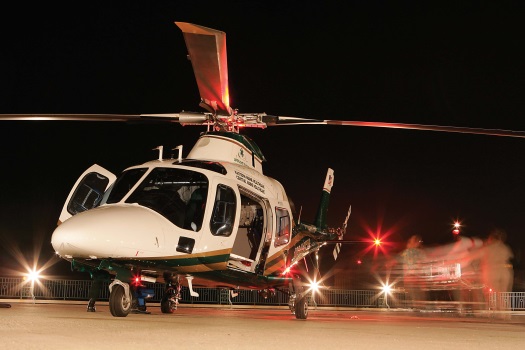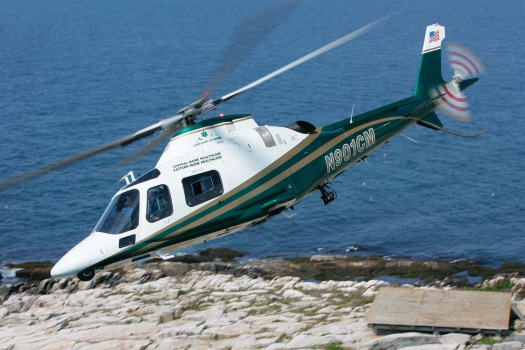
SevenBar Aviation will operate LifeFlight of Maine’s two AgustaWestland AW109Es, and add a Beechcraft King Air B200 to the air medical service’s fleet. Mike Reyno Photo
SevenBar Aviation and LifeFlight of Maine have announced a new partnership that will launch the aviation provider’s newly-formed rotary-wing division, and see the East Coast air medical program provided with its first fixed-wing aircraft. SevenBar, based in Dallas, Texas, will be taking over aviation duties for the program from Era Helicopters on April 1, and, in addition to flying LifeFlight of Maine’s two AgustaWestland AW109Es, will add a Beechcraft King Air B200 to their fleet.
SevenBar has provided fixed-wing aviation services for air medical programs for almost 40 years, but announced that it would be making the move into rotary-wing operations at the Air Medical Transport Conference (AMTC) in Nashville, Tenn., last September. At the time, it promised to bring an “innovative and creative” operating paradigm to the helicopter emergency medical services (HEMS) community.
“Entering our relationship with LifeFlight of Maine really is allowing us to both think about that new paradigm and develop it together,” Kim Montgomery, president of SevenBar, told Vertical. “We and LifeFlight of Maine think that maybe there’s room for a whole new way of doing things in the industry — and even maybe a whole new operating and service delivery model — where there really is a lot more alignment between the medical program and the air operator. And I think that is what we, together, are going to be working on evolving towards. And we hope that once we develop it, that it will be something that can be shared with the entire industry.”
Montgomery said both SevenBar’s move into helicopter operations and the partnership with LifeFlight of Maine have been years in the making. The latter began when the air medical program started making enquiries about the possibility of adding a fixed-wing element to its fleet.
“As we spent more and more time getting to know one another, we saw a lot of alignments between the values of LifeFlight of Maine and the values of SevenBar,” she said. “We were working to expand our own services into rotor-wing operations, and it just became a natural evolution and a realization that we could provide both those services to LifeFlight of Maine, and that would create a lot of efficiency in their operation.”
LifeFlight of Maine is a non-profit hospital-based program that serves the entire state — a largely rural region that includes many remote areas and islands. Established in 1998 at a time when there were only two hospital helipads in the whole of Maine, it subsequently led a statewide effort to develop a state-of-the-art aviation infrastructure. Today, it receives about 2,300 calls each year. “We provide critical care across the state with helicopters and specially equipped ground ambulances. Over thirty percent of our transports are on the ground,” said Tom Judge, executive director of LifeFlight of Maine. “Our job is to move patients safely and effectively. Just because we have helicopters, doesn’t mean we’re going to put someone in a helicopter. We align the right vehicle to patient need and safety considerations.”
The program’s new King Air will be based at Bangor International Airport in the center of the state, where LifeFlight of Maine already has a hangar. (Its helicopters are based at Eastern Maine Medical Center in Bangor, and Central Maine Medical Center in Lewiston.)
“It’ll give us a long distance capability that we don’t have, some improved all-weather performance that sometimes we struggle with, and it’ll give our entire region a new asset,” said Judge. “It’ll give that group of patients that today has pretty limited options, new options.”

LifeFlight of Maine’s helicopters are based in Bangor and Lewiston. Mike Reyno Photo
Judge said the impetus behind the search for a new partner, in addition to the need for a fixed-wing service, was the reality of a changing healthcare system.
“We are really focused on the concept of partners,” he said. “We need close alignment with our values and what we believe about the future of medicine. We need commitment to the ‘Triple Aim’ all of us in healthcare are challenged with: improving population health; providing better, higher quality care; and doing it at less per capital cost.
“I think what’s exciting to us about SevenBar is that they are looking out at the future of healthcare and they’ve said, ‘Our competence is aviation, but we brought some healthcare people to the center of our organization and we understand that in the world of the future, we’re going to have to have a very different delivery of healthcare through the transportation lens.’ We came to the conclusion that their approach, values, commitment to safety, and their philosophy were very aligned with ours.”
Montgomery said that as the healthcare community is changing, the way that aviation providers work has to change as well. “I think we’re both open to whatever that means – funding, payment, service delivery, sharing of assets — there’s a lot of possibilities.”
Wade Black, the CEO and owner of SevenBar, said his company’s community focus — inherited from its origins as a family business — meshed well with that of LifeFlight of Maine, while the provider’s small size allowed it greater flexibility to adapt the needs of its customers.
“Our whole set of values derives from our ability to be extremely adaptable, having a learning culture, being able to address the needs of our customers and really being oriented towards the customer and delivering customer service,” he said. “From an air medical standpoint, what we’re all here for is the patient. If we’re able to deliver them safely and to do everything that we can to support the medical teams like LifeFlight of Maine, and make their jobs easier, then we’ve done our job.”
SevenBar plans to announce further partnerships over the next 12 months (including the destination for the AgustaWestland AW109SP it took delivery of at AMTC), but Montgomery said the operator’s growth would be steady. “Obviously we plan to grow, but it’s not that we’re going to have skyrocketing growth. We have no desire to be the biggest. We want to be the best for the people that are right for us to work with — and vice versa.”









